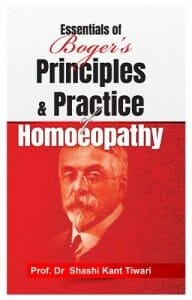We have Lectures on Homoeopathic Philosophy by Kent, Principles and Art of cure by HA Robert, The Genius of Homoeopathy by Stuart Close as guide book on principles of Homoeopathy but no book on Principle and Practice of Homoeopathy by Boger. This book fills the lacunae. The author collected various lectures and articles by Boger and complied in the form of book for the prospects of homoeopathic education and practice.
In this book, several really intriguing cases are recreated and successfully handled by Boger. Reading those cured cases is incredibly enjoyable, and each case offers useful lessons.
This missionary labour was completed through a thorough and exhaustive study of all relevant literature referring to homoeopathy teaching and practise during the Boger era, as well as compilation of that literature (1890-1935).
This book only contains papers that were deemed to be extremely important and useful for students and practitioners.
This book, Essentials of Boger’s Principle and Practice of Homoeopathy, is a “collection” to “link” the dispersed useful notions considered by Boger, which defines the fundamentals and the methodology of logical and effective clinical practise of homoeopathy.
In the form of lectures, presentations, conversations with prominent contemporary thinkers and practitioners, case analyses, and recommendations by Boger at various times and circumstances on numerous platforms, these were laying unattended were included in this book.
A collection of 66 essays on homoeopathy that are being presented as an assembled jewel in book form made out of extremely valuable pearls found lying at various locations is also known as a “piece of gems” or “piece of jewels” on homoeopathy. These pearls are anticipated to significantly increase the riches of homoeopathy.
Interesting Chapters
- What is homoeopathy
- Homoeopathic Science
- What does homoeopathy stand for
- The standing of Homoeopathy
- What homoeopathy means
- The evolution of homoeopathy
- Why homoeopathy
- A contribution on relation of homoeopathy to the sciences
- The law of cure
- The philosophy of similia
- What we should know
- Studies in the philosophy of healing
- Vital Energy
- Language of disease
- Taking the case
- How to take the case
- The similimum
- Finding the similimum 1
- Finding the similimum 2
- Finding the similimum with the help of family analysis
- The power of the similimum
- The indicated remedy
- What indicates the remedy
- How shall I find the remedy
- Some thoughts on prescribing
- What divides us
- Homoeopathic reaction
- Grading of symptoms
- Philosophy and the repertory
- Rason and fact
- Random notes
- Observation on prescribing
- Correct prescribing
- Is there a law of dose
- Choosing the remedy
- The repetition of the dose 1
- The repetition of the dose 2
- Regularity and progress
- The undeveloped picture
- The whole case
- Suppression
- Sings and the law
- The relation of homoeopathy to pathology
- The genus epidemicus
- Clinical cases and verifications
- Tuberculosis – medical side of the question
- Three liver cases
- The homoeopathic view points in cancer
- Panaritium
- The metals and their functions in reproductive organs
- Points in obstetrical therapeutics
- Climacteric remedies
- Diabetic gangrene
- Clinical cases
- A case of cholecystitis
- The choleraic complex
- Homoeopathy in disease of children
- The sick child
- The study of materia medica
- The development of the materia medica
- Materia medica – a study
- The genius of our materia medcia
- The strontium salts
- Gymnacladu
- Veterinary homoeopathy
- President’s address
I recommend this book to the students’ teachers and practitioners of homoeopathy for a better simplified understanding of our principles and practice.
Author
Dr SK Tiwari
Prof. Dr Shashi Kant Tiwari, author of Essentials of Repertorization, Boenninghausen-Boger Final General Repertory and various other books had a great enthusiastic and inquisitive search regarding Boger’s methods of prescribing. After going through several writings of Boger, he has selected some of 66 lessons which are essential for knowing Boger’s principles of prescribing. Having served Homoeopathy in various capacity like – Director, National Institute of Homoeopathy (Govt. of India); Principal, Fr Muller Homoeopathic Medical College Mangalore; Dean of Education, DLN Homoeopathy Medical Education and Research Winnipeg Canada and also being teacher and examiner for 40 years of Degree and Post Graduate courses as well as in Certificate course for Veterinary Homoeopathy, Dr Tiwari has a vast knowledge and experience in the subject of Repertory especially regarding the Boger’s Principles and Practice. A few of these related to Boger have been compiled in this precious book.
Pages : 326
Rs. 276
ISBN : 9788131928219
Purchase online : https://www.bjainbooks.com/product-detail/essentials-of-boger-s-principles-practice-of-homeopathy


Be the first to comment